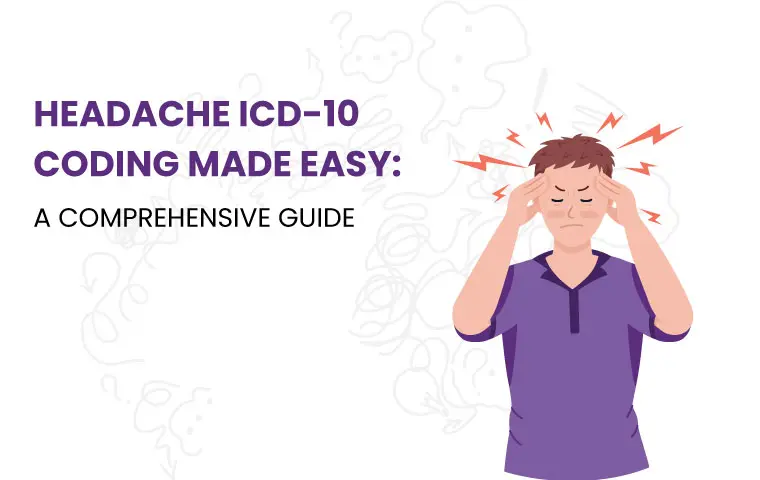As a health care provider you may have a sense that accurate coding is key for maximized reimbursement in medical billing. But what is accurate coding in terms of headache. Finding the right code can itself give you a headache. Let’s create a scenario: You are in you clinic suddenly a women aged 45 years old approaches your clinic and complains about headache.
You may feel a sense of confusion creeping that which type of headache icd 10 code should you use. Is it a tension type headache? A headache caused due to migraine with aura? Or something entirely different? So to take you out from this confused condition, we will take a closer look at some of the different types of headaches and the corresponding icd 10 codes so that you can code with more confidence.
Why Headache is caused and its symptoms?
Headaches can have a variety of causes, ranging from stress and tension to underlying medical conditions. Some of the most common Causes that are found are listed as follow:
- Dehydration
- Lack of sleep
- Sinus infections
- Migraines
Symptoms of a headache can vary depending on the cause, but often include:
- Dizziness or lightheadedness
- Neck or shoulder pain
- Jaw pain or stiffness
- Tenderness or pain in the scalp, forehead, or temples
- Tingling or numbness in the face, head, or neck
- Visual disturbances, such as seeing spots or flashing lights
- Difficulty concentrating or thinking clearly
- Irritability or mood changes
- Loss of appetite
Different Types of Headaches
There are several different types of headaches, each with their own set of symptoms and underlying causes. Here are some of the most common types:

Tension-type headaches: These are the most common type of headache, and are often caused by stress, poor posture, or muscle tension in the head and neck.
Migraines: Migraines are a type of headache that are often characterized by severe, throbbing pain on one side of the head, along with nausea, sensitivity to light and sound, and sometimes visual disturbances.
Cluster headaches: Cluster headaches are a rare but extremely painful type of headache that typically occur in cyclical patterns, with periods of frequent attacks followed by periods of remission.
Sinus headaches: Sinus headaches are caused by inflammation or infection in the sinuses, and are often accompanied by facial pain or pressure, congestion, and a runny nose.
Hormonal headaches: Women may experience headaches related to hormonal changes during their menstrual cycle, pregnancy, or menopause.
Rebound headaches: Rebound headaches are caused by overuse of pain medications, and can occur when someone takes pain relievers frequently to manage headaches.
Exertion headaches: Exertion headaches are caused by physical activity, such as running, weightlifting, or even sexual activity.
What ICD-10 Codes You Should Use?
Now that you have a better understanding of the different types of headaches, you may be wondering which ICD-10 codes to use for each type. This is where we'll dive into the appropriate codes for each type of headache, so you can code with confidence and ensure that your patients receive accurate and effective care.
ICD 10 Codes for Headache
According to AAPC headache has been categorized into 2 Group Sets
- Headache with orthostatic component, not elsewhere classified
- Headache, unspecified
Headache with orthostatic component, not elsewhere classified
R51.0 is a billable ICD 10 code used for Headache with orthostatic component.
Headache, unspecified
The ICD 10 code for headache unspecified is R51.9
Migraine headache ICD 10 Codes
There are several different ICD-10 codes that can be used to classify and code migraines, depending on the specific type and characteristics of the migraine. Here are some of the most commonly used ICD-10 codes for migraines:
- G43.009: Migraine without aura, not intractable, without status migrainosus
- G43.001: Migraine without aura, not intractable, with status migrainosus
- G43.109: Migraine with aura, not intractable, without status migrainosus
- G43.119: Migraine with aura, intractable, with status migrainosus
- G43.9: Migraine, Unspecified
Tension headache icd 10 Codes
Tensioned type headache is further categorized in to 2 types
- Episodic tension-type headache
- Chronic tension-type headache
Episodic tension-type headache
Episodic tension-type headache is a type of headache that is characterized by mild to moderate, bilateral (affecting both sides of the head), pressing or tightening pain that is not accompanied by other symptoms such as nausea, vomiting or sensitivity to light or sound. G44.21 is the billable code for this type of headache
Chronic tension-type headache
Chronic tension-type headache is a type of headache that is characterized by a continuous or nearly continuous headache that lasts for hours to days, often with a mild to moderate intensity. Providers need to use G44.22 for chronic tension type headaches.
Tension-type headache, unspecified, refers to a headache that has some characteristics of a tension-type headache, but does not fit into the criteria for either episodic or chronic tension-type headache. G44.20 is used when headache type is unspecified.
Cervicogenic headache ICD 10 Code
Cervicogenic headache is a type of headache that originates from the cervical spine or neck region. The pain is usually unilateral (affecting one side of the head), and is often described as a dull ache that can be accompanied by neck pain, stiffness, and restricted range of motion. G44.86 is labeled as Cervicogenic headache ICD 10 code.
Post Traumatic Headache ICD 10 Codes
Post-traumatic headache is a type of headache that develops after a head injury or trauma, such as a concussion. The headache can be acute, meaning it occurs within hours to days after the injury, or it can be delayed, occurring weeks to months after the injury. ICD 10 codes for post traumatic headache is G44.3.
Coding Guidelines to Follow While Documenting ICD 10 Code for Headache
The American Academy of Professional Coders (AAPC) provides some additional coding guidelines for headaches, which include:
Code to the highest level of specificity: It is essential to be specific when documenting headaches. The AAPC recommends coding to the highest level of specificity, which means using the most detailed code available for the type of headache being treated.
Document the cause of the headache: Documenting the cause of the headache, such as trauma or infection, can help to determine the appropriate code to use. If the headache is due to an underlying medical condition, such as hypertension or a brain tumor, the underlying condition should also be coded.
Use the correct modifiers: Modifiers can be used to indicate the type and/or severity of the headache, as well as any treatments that were performed. For example, modifier -25 can be used to indicate that a significant, separately identifiable evaluation and management (E/M) service was provided on the same day as a procedure, such as a nerve block or injection.
Be aware of potential coding errors: The AAPC cautions coders to be aware of potential coding errors when coding for headaches, such as using a code for a specific type of headache when the documentation only supports a general headache code.
Consult with experts: As with any coding situation, it is important to consult with professional Medical Coders to clarify any questions or concerns about the documentation and to ensure that the coding accurately reflects the services provided.
Overall, accurate and detailed documentation is key to ensuring that headaches are coded correctly. By following these guidelines and seeking guidance when necessary, medical coders can help to ensure that headaches are coded accurately and efficiently.
Final Words
In conclusion, accurate coding is crucial for healthcare providers to receive proper reimbursement and ensure that their patients receive the best possible care. When it comes to coding headaches, it's important to be specific and document the underlying cause of the headache, as well as the type and severity of the headache.
By following coding guidelines and consulting with experts, medical coders can ensure that headaches are coded accurately and efficiently. With this knowledge, healthcare providers can treat their patients with confidence and ease, without the added headache of incorrect coding.
ABOUT AUTHOR

Sam Curran
As a blog writer with years of experience in the healthcare industry, I have got what it takes to write well researched content that adds value for the audience. I am a curious individual by nature, driven by passion and I translate that into my writings. I aspire to be among the leading content writers in the world.
